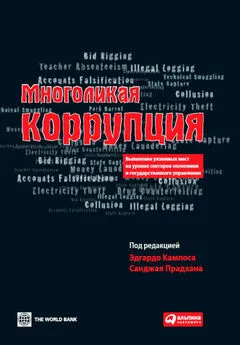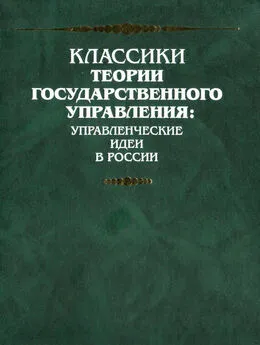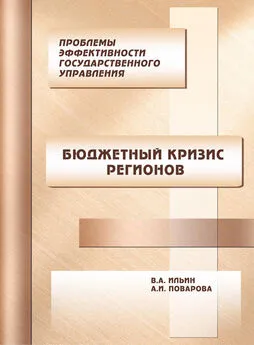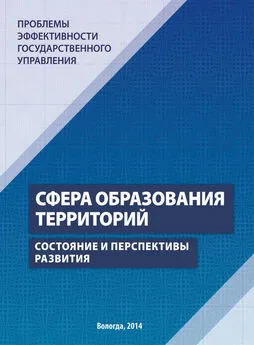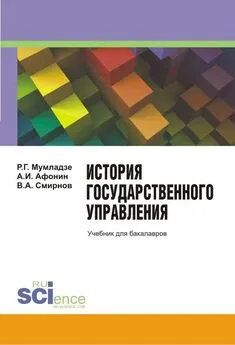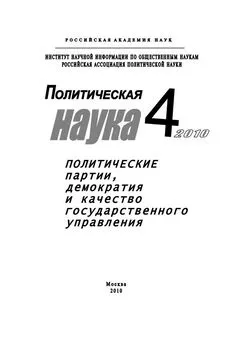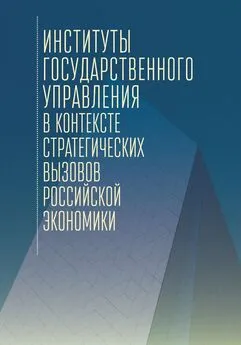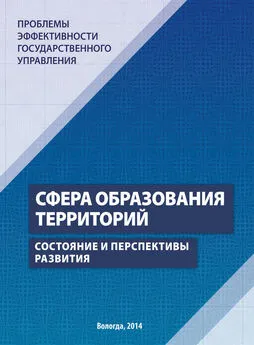Санджай Прадхана - Многоликая коррупция. Выявление уязвимых мест на уровне секторов экономики и государственного управления
- Название:Многоликая коррупция. Выявление уязвимых мест на уровне секторов экономики и государственного управления
- Автор:
- Жанр:
- Издательство:Array Литагент «Альпина»
- Год:2010
- Город:Москва
- ISBN:978-5-9614-2185-9
- Рейтинг:
- Избранное:Добавить в избранное
-
Отзывы:
-
Ваша оценка:
Санджай Прадхана - Многоликая коррупция. Выявление уязвимых мест на уровне секторов экономики и государственного управления краткое содержание
Многоликая коррупция. Выявление уязвимых мест на уровне секторов экономики и государственного управления - читать онлайн бесплатно полную версию (весь текст целиком)
Интервал:
Закладка:
Приложение 3А: Примеры незаконных вырубок и связанной с ними незаконной практики в лесном хозяйстве
Незаконные вырубки
• Вырубка охраняемых видов деревьев.
• Использование поддельных лицензий на вырубку.
• Кольцевание деревьев, которое ведет к их гибели и законной вырубке.
• Заключение контрактов с местными предпринимателями на покупку лесоматериалов из охраняемых зон.
• Вырубка в охраняемых зонах.
• Вырубка за пределами района, указанного в концессионном договоре.
• Вырубка в запрещенных зонах, таких как крутые склоны, берега рек и водосборные бассейны.
• Удаление недостаточно больших или слишком больших деревьев из государственных лесов.
• Вырубка сверх разрешенного объема.
• Выдача древесины, полученной в районах за пределами указанного в концессионном договоре, за вырубленную законно.
• Вырубка без разрешения.
• Получение концессий на вырубку за взятку.
Незаконная транспортировка, торговля и контрабанда древесины
• Транспортировка лесоматериалов без разрешения.
• Транспортировка незаконно вырубленного леса.
• Контрабанда древесины.
• Фальсификация или повторное использование транспортных документов.
• Экспорт и импорт видов деревьев, запрещенный международными законами, например Конвенцией о международной торговле исчезающими видами дикой флоры и фауны.
• Экспорт и импорт древесины в нарушение международных запретов.
Трансфертное ценообразование и другая незаконная практика учета
• Объявление более низкой стоимости и объема экспорта.
• Объявление цены, превышающей средние рыночные цены, при покупке оборудования или услуг связанных компаний.
• Использование кредиторской задолженности для перебрасывания средств в дочернюю или материнскую компанию, например с помощью раздувания долга, с целью избежания уплаты налога на прибыль.
• Участие в сговоре при предложении цены для удешевления концессии.
• Уклонение от уплаты сборов и платы за использование природных ресурсов с помощью понижения класса древесины, занижения ее стоимости, размера и неверной классификации видов, предназначенных для экспорта или местного рынка.
• Неуплата лицензионных платежей, платы за использование природных ресурсов и других правительственных сборов.
Незаконная переработка древесины
• Работа без лицензии на переработку.
• Игнорирование экологических, социальных и трудовых законов и правил.
• Использование незаконно полученной древесины.
Источник: основано на Callister (1999) и Contreras (2002).Литература
Acosta, R. T. 1999. «Forest Management and Protection: The Philippine Experience .» Paper prepared for the Regional Symposium on Strengthening Cooperation for Forest Law Enforcement in Mekong Basin Countries, Phnom Penh, Cambodia, June 14–15.
Akella, Anita Sundari, and James B. Cannon. 2004. Strengthening the Weakest Links: Strategies for Improving the Enforcement of Environmental Laws Globally . Washington DC: Conservation International.
Barreto, Paulo, Carlos Souza Jr., Ruth Noguerón, Anthony Anderson, and Rodney Salomão (in collaboration with Janice Wiles). 2006. Human Pressure on the Brazilian Amazon Forests . Washington, DC: IMAZON, Global Forest Watch, and World Resources Institute.
bin Buang, Amah. 2001. «Forest Management Experiences from East Asia.» Paper delivered at the Forest Law Enforcement and Governance: East Asia Ministerial Conference, Bali, Indonesia, September 11–13. http://lnweb18.worldbank.org/eap/eap.nsf/2500ec5f1a2d9bad852568a3006f557d/c19065b26241f0b247256ac30010e5ff?OpenDocument.
Blaser, Juergen, A. Contreras, T. Oksanen, E. Puustjarvi, and F. Schmithusen. 2005. «Forest Law Enforcement and Governance (FLEG) in Eastern Europe and Northern Asia (ENA).» Reference paper prepared for the St. Petersburg Ministerial Conference, November 22–25.
Callister, Debra J. 1999. «Corrupt and Illegal Activities in the Forestry Sector: Current Understandings and Implications for World Bank Forest Policy.» Discussion draft (May). http://wbln0018.worldbank.org/essd/forestpol-e.nsf/HiddenDocView/BCE9D2A90FADBA73852568A3006493E0?OpenDocument.
Chomitz, Kenneth. 2006. At Loggerheads? Agricultural Expansion, Poverty Reduction, and Environment in the Tropical Forests . Washington, DC: World Bank.
Claridge, Gordon, Veasna Chea-leth, and In Van Chhoan. 2005. «The Effectiveness of Law Enforcement against Forest and Wildflife Crime: A Study of Enforcement Disincentives and Other Relevant Factors in Southwestern Cambodia.» East-West Management Institute, Conservation International, and U. S. Agency for International Development, Washington DC (September).
CEPI (Confederation of European Paper Industries). 2005. Illegal Logging: Codes of Conduct for the Paper Industry. Brussels.
Contreras-Hermosilla, A. 2002. «Law Compliance in the Forestry Sector: An Overview.» WBI Working Papers, World Bank Institute, Washington, DC, http://lnweb18.worldbank.org/eap/eap.nsf/2500ec5f1a2d9bad852568a3006f557d/c19065b26241f0b247256ac30010e5ff?OpenDocument.
Contreras-Hermosilla, A., and M. T. Vargas. 2002. «Social, Environmental and Economic Dimensions of Forest Policy Reforms in Bolivia.» Forest Trends, Washington, DC. http://www.forest-trends.org/whoweare/pdf/BoliviaEnglish.pdf.
Damania, R., R. Deacon, and E. Bulte. 2005. «Resource Abundance, Poverty and Development: An Empirical Assessment.» World Development 33: 1029–1054.
Dixit, Avinash K. 2004. Lawlessness and Economics: Alternative Modes of Governance. Princeton, NJ: Princeton University Press.
Dykstra, Dennis P., George Kuru, Rodney Taylor, Ruth Nussbaum, William B. Magrath, and Jane Story. 2003. «Technologies for Wood Tracking: Verifying and Monitoring the Chain of Custody and Legal Compliance in the Timber Industry.» Discussion paper, Environment and Social Development, East Asia and the Pacific Region, World Bank, Washington, DC.
ECSSD/PROFOR (Europe and Central Asia Socially Sustainable Development Department/Program on Forests). 2005. «Forest Institutions in Transition: Experiences and Lessons from Eastern Europe.» World Bank, Washington, DC (February).
EIA (Environmental Investigation Agency) and Telapak Indonesia. 2001. «Timber Trafficking.» (September). http://www.eia-international.org.
EIA (Environmental Investigation Agency) and Telapak Indonesia. 2006. «America’s Free Trade for Illegal Timber: How US Trade Pacts Speed the Destruction of the World’s Forests.» http://www.eia-international.org/files/news312–1.pdf
Embido, Oscar. 2001. «Forest Law Enforcement and Investigation Techniques in the Philippines.» Paper delivered at the Forest Law Enforcement and Governance: East Asia Ministerial Conference, Bali, Indonesia, September 11–13. http://lnweb18.worldbank.org/eap/eap.nsf/2500ec5f1a2d9bad852568a3006f557d/c19065b26241f0b247256ac30010e5ff?OpenDocument.
FAO (Food and Agriculture Organization). 2001. «Global Forest Resources Assessment 2000.» FAO Forestry Paper 140, FAO, Rome.
FAO (Food and Agriculture Organization). 2005. «Best Practices for Improving Law Compliance in the Forest Sector.» FAO Forestry Paper 145, FAO and International Tropical Timber Organization, Rome.
FAO (Food and Agriculture Organization). 2006. «Global Forest Resources Assessment 2005.» FAO Forestry Paper 147, FAO, Rome.
Forest Trends. 2006. Logging, Legality and Livelihoods in PNG: Synthesis of Official Assessments of the Large-Scale Logging Industry, vol. 1. Washington, DC: Forest Trends.
Glastra, R., ed. 1999. Cut and Run: Illegal Logging and Timber Trade in the Tropics. Ottawa: International Development Research Centre.
Global Forest Watch. 2005. Interactive Forestry Atlas of Cameroon (Version 1.0). An Overview. Washington, DC: Global Forest Watch, Ministry of Environment and Forestry, Cameroon, and World Resources Institute – a Global Forest Watch Report.
Global Witness. 2000. «Chainsaws Speak Louder thanWords .» Briefing document, Global Witness, London. http://www.globalwitness.org/campaigns/forests/cambodia/reports.html.
Global Witness. 2001. «The Credibility Gap – and the Need to Bridge It.» Briefing document, London. http://www.globalwitness.org/campaigns/forests/cambodia/reports.html.
Global Witness. 2005. A Guide to Independent Forest Monitoring. London: Global Witness.
Gray, John. 2002. «Forest Concession Policies and Revenue Systems: Country Experience and Policy Changes for Sustainable Tropical Forestry.» Technical Paper 522, World Bank, Washington, DC.
Greenpeace. 2001. «Partners in Mahogany Crime: Amazon at the Mercy of ‘Gentlemen’s Agreements.» Greenpeace International, Amsterdam (October).
Isham, Jonathan, Michael Woolcock, Gwen Busbly, and Lant Prichett. 2005. «The Varieties of Rentier Experience: How Natural Resource Endowments Affect the Political Economy of Economic Growth.» UC Berkeley Discussion Paper, University of California, Berkeley.
ITTO (International Tropical Timber Organization). 2000. «Review of Progress towards Year 2000 Objective.» ITTO, Yokohama, Japan.
ITTO (International Tropical Timber Organization). 2002. «Ecuador’s New Approach to Enforcing Forest Law.» Tropical Forest Update 12 (1). http://www.itto.or.jp/newsletter.
Kishor, Nalin. 2004. «Review of Formal and Informal Costs and Revenues Related to Timber Harvesting, Transporting and Trading in Indonesia.» Informal note, World Bank, Washington, DC.
Klitgaard, Robert. 1988. Controlling Corruption . Berkeley: University of California Press.
Читать дальшеИнтервал:
Закладка:
